2024 Hyundai Kona N Line Review: Going Its Own Way
Among an increasingly competitive flock of volume-seller compact crossovers, one South Korean offering looks like nothing else on the road in North America. So different is the 2024 Hyundai Kona, even compared with the first-generation version it replaces, it might even take people some time to figure out what the stylish little SUV even is.
As of the 2024 model year, Hyundai’s subcompact Kona is in its second generation. We loaned an N Line variant—the sportiest and second-highest of the Hyundai’s trims—for a long weekend in California and hit the highways of San Francisco, the neighborhoods of Berkeley, and the curves of the Marin headlands to see whether this urban trucklet improves upon its predecessor.
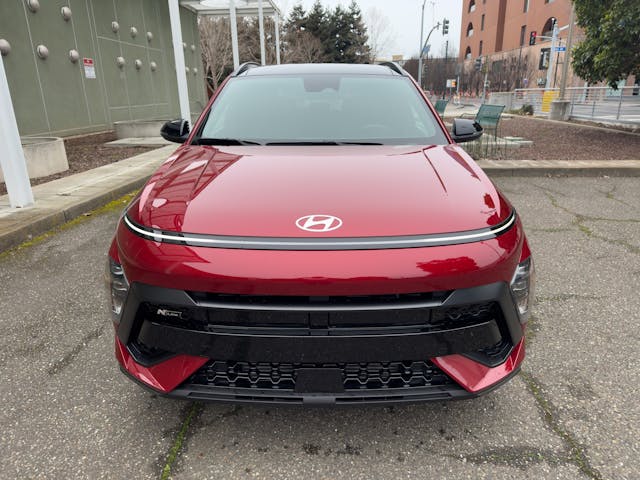
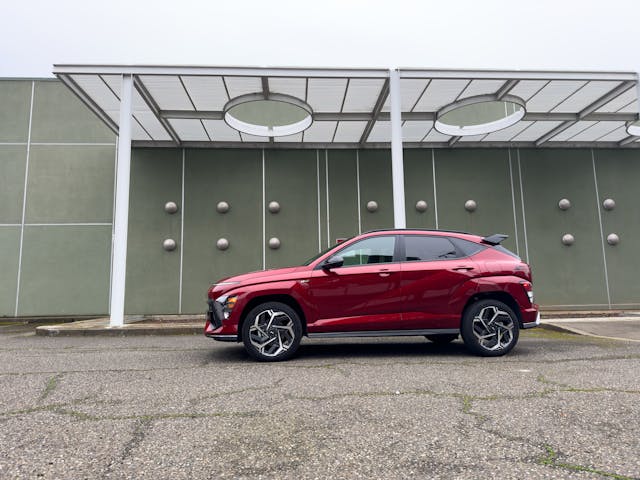
Let’s begin with the comprehensive changes that define this new-era Kona. Longer, wider, and taller than the first-gen (2018–22) car, the 2024 Kona looks … weirder. If the first-gen car was a mix of funky and adorkable, this follow-up is a mix of R2D2 and robot dog. It’s still cute but with an edgier, more futuristic flair. One reason consumers may struggle to identify it as a Hyundai is that the company’s product range includes so many different aesthetics: The softly contoured, big-grilled Venue; the blocky 2024 Sante Fe with its eight-bit-inspired headlights, a retro vibe shared by the Ioniq 5 electric hatchback; the teardrop-shaped, doe-eyed Ioniq 6 electric sedan; the aggressively flashy but gently surfaced Palisade SUV. The Kona, with its unbroken slit of LED running lights high on its snub nose, and headlights pushed nearly into the fender flares, looks like none of the other Hyundai vehicles. The knife-like creases on the sides of the new Kona are similar to those of the techno-Brutalist Ioniq 5 … but there the similarities end. Despite the inconsistency of the overall lineup, we honestly like the look of the new Kona.
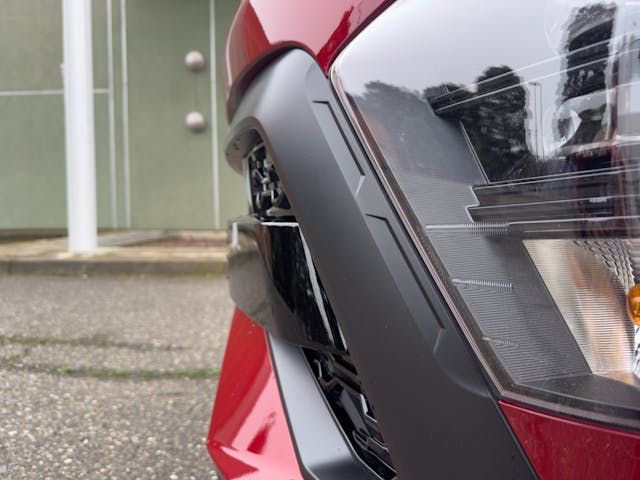
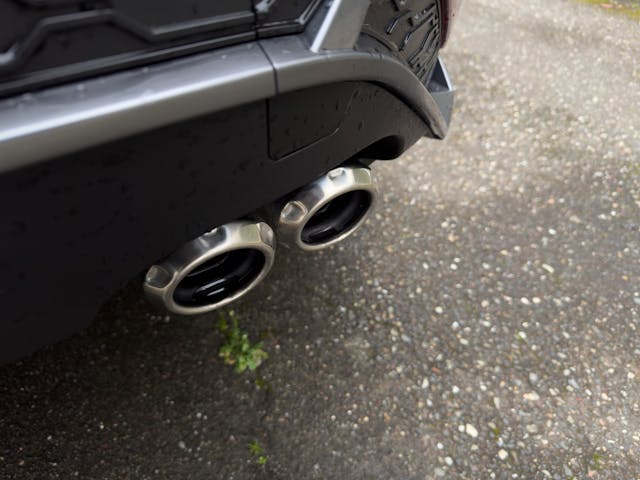
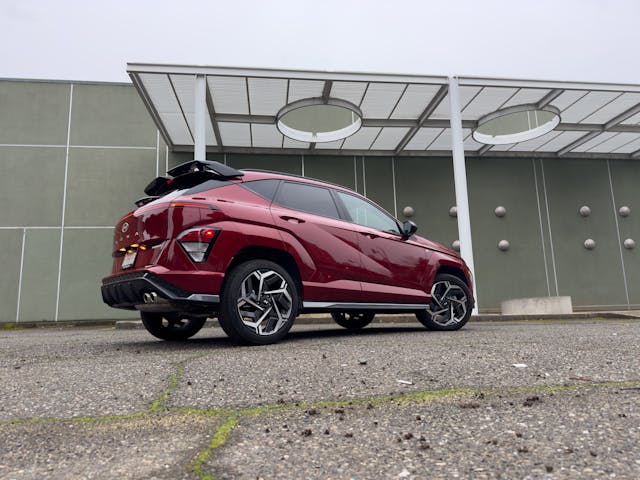
Hyundai originally launched the Kona for the 2018 model year with four trims: SE, SEL, Limited, and Ultimate, adding the electric variant as a separate model in 2019. Upon the introduction of the sporty-chic N Line variant for 2022, Hyundai fired Ultimate, promoted Limited, and backfilled the latter with the N Line. (The grin-inducing, 276-hp N model arrived for 2022.) That arrangement worked well, apparently, because the hierarchy carries over to the second-gen. The bones of the two cars are similar, as well: Hyundai stretched the platform of the first-gen Kona and tailored it for the second-gen EV model, known as the Kona Electric, then for the gas-engine versions. (This enabled Hyundai to build a plug-in hybrid model on the same chassis, though that powertrain isn’t available in the States.)
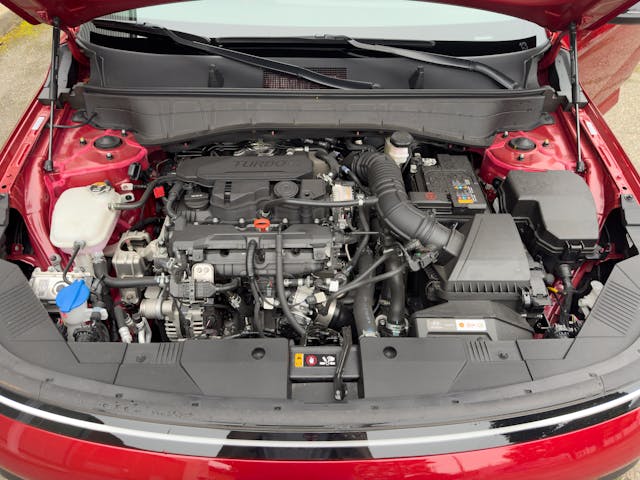
Like the outgoing car, the new Kona offers two gas powertrains. The base engine remains the 2.0-liter, naturally aspirated four-cylinder (147 hp and 132 lb-ft of torque), included on the lower two of the four trims: SE and SEL. The higher two (N Line and Limited) again receive a 1.6-liter direct-injection engine blessed with a turbocharger, but for 2024 there are a couple of changes to its setup: Though torque output remains the same, at 195 lb-ft, the 1.6-liter now makes 5 fewer horsepower (190 total). It is mated to a shift-by-wire eight-speed automatic that replaces the previous seven-speed dual-clutch unit. All four gas-powered Kona trims are available in front- or all-wheel drive. The latter carries a $1500 upcharge, regardless of trim, and adds a third drive mode: Snow.
Specs: 2024 Kona N Line AWD
- Price, base/as tested: $33,485 / $33,695
- Powertrain: 1.6-liter, turbocharged inline-four engine, shift-by-wire eight-speed torque-converter automatic transmission
- Horsepower/Torque: 190 hp @ 6000 rpm, 195 lb-ft of torque @ 1700–4500
- Layout: All-wheel-drive, four-door, five-passenger crossover
- Curb weight: 3483 pounds
- EPA-rated fuel economy: N/A. Manufacturer estimate: 24/29/26 (city/highway/combined)
- 0–60 mph: 8.5 seconds (est.)
- Competitors: Kia Niro, Mazda CX-30, Chevrolet Trailblazer, Buick Envista, VW Taos
The aesthetic differences compared with the outgoing Kona N Line are obvious at first glance—the absence of the three slits in the nose, the distinct and highly angular front and rear lower fascia, and the honking big spoiler mounted on the trunk. (The spoiler reminds us of the now-dead Veloster N, and that makes us sad.) The look is completed by a set of 19-inch wheels adorned with center caps bearing the N logo of the company’s performance division, which didn’t appear to have much material input on this car.
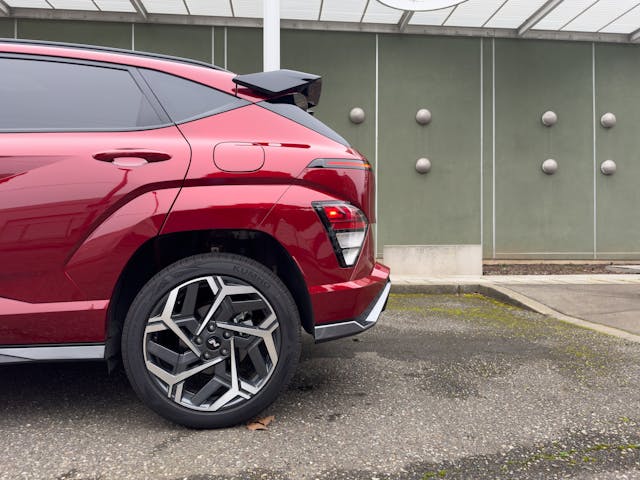
The N Line is a show-not-go trim. Unlike its predecessor, there is no mechanical difference between the N Line and the other three trims. The main letdown is the eight-speed transmission. Even in Sport mode, downshifts using the paddle shifters show up a half-second after you request them. To be fair, Sport mode will hold gears with admirable tenacity, but the fun of tossing about what seems to be a decent car with a competent chassis and fairly spunky engine is undercut by the dawdling arrival of said gear.
Our irritations with the transmission weren’t singular. When faced with the surging, steep neighborhood streets of Berkeley Hills, the transmission would allow engine speed to slump below 1000 rpm, which is 700 rpm below the low end of the peak torque range. When we brought the car to a halt at a neighborhood stop sign, the eight-speed transmission would realize the task before it and hang onto first, then second to keep revs between 1700 and 4500 rpm, and the difference in peak torque was significant. When the transmission cooperated, the setup felt plenty peppy.
On highways and byways, the Kona N Line faded into the background. The driveline packs enough punch for purposeful highway passes—if you twist the drive-mode selector to Sport, the task is far more pleasant—and is quiet above 70 mph. The car’s steering fails to transmit any meaningful information about the road through the wheel, but it’s otherwise unobtrusive. The seats held your five-foot-six author in reasonable security even during the attempted back-roads shenanigans and never produced a twinge of discomfort during longer highway stints. Though it is a larger vehicle than the one it replaces, the 2024 Kona is small enough to easily parallel park, and good outward visibility minimizes the stress of the process. Loading groceries or luggage into the trunk (25.5 cubic feet with seats up, 63.7 if they’re down) is easy, thanks to a friendly load height and a tailgate that swings well above your author’s head.
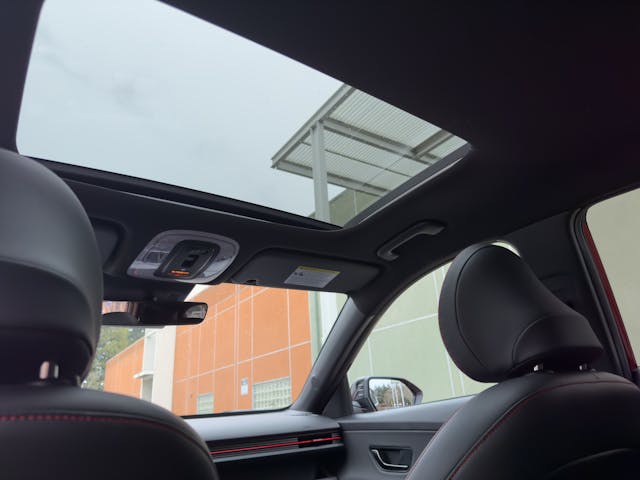
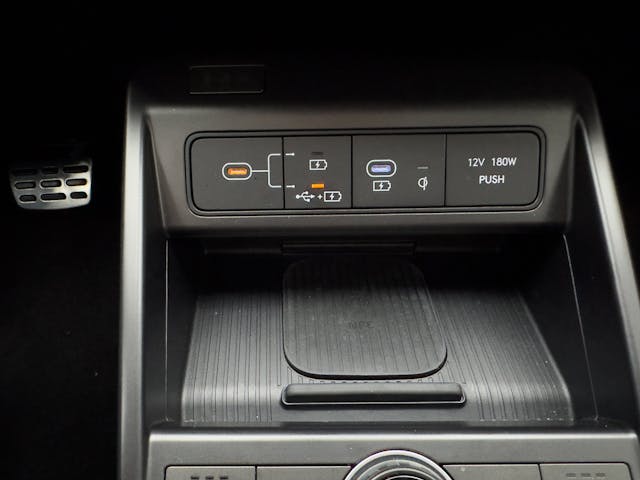


The interior does the heavy lifting to make this car feel worth its $34K price tag (about $3000 more than the first-gen N Line we tested in 2022). The lines are clean and geometric, and symmetry rules: The dash is nearly flat, pillar to pillar, and accented with a single red line. It is mounted with a two-in-one rectangular screen that rises above a friendly set of buttons. As with most new cars, the only direct charging ports are of the USB-C variety, and the cupholders won’t fit a 32-ounce Hydroflask. The diversity and quality of materials make this cabin feel refined: The seats are upholstered in part with Alcantara, unique to the N Line trim; the frame around several buttons wears a satin-brushed effect; and the pedal covers and sill plates are aluminum. Headrests wear the N logo, but on the steering wheel the Hyundai H is absent; in its place is a silver-colored bar with four depressions, echoing the treatment we’ve seen in Hyundai’s Ioniq 5 and 6.
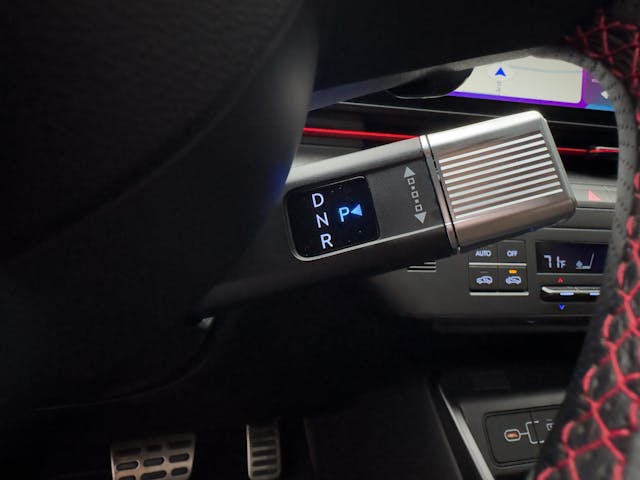
Our only niggles about the interior: One, the twist action of the column-mounted gear shifter is fussy, though the piece itself, with its finned metallic finish and rectangular cross-section, feels like it’s made solidly. The action takes some getting used to; it took me some time to find the shifter when I first got in the car, and several seconds to realize I was supposed to twist the end of the stalk to shift into drive, rather than lever the whole arm, as you would if it were hinged at the column. “Park,” a la BMW, is activated by pressing the button on the end of the stalk. Another, smaller complaint: The matte plastic sections of the door cards show grease. (I was in California, and I like cheeseburgers, so of course I visited In-N-Out.)
As with all Hyundais, the warranty is excellent: five years or 50,000 miles for the whole vehicle, 10 years or 100,000 miles for the powertrain. You’ll get complimentary maintenance for three years and unlimited-mile roadside assistance for five. However, if you’re not gaga over $33,695 N Line’s body kit, and care more about dollars than horsepower, you’ll be better served by the SE or SEL model.
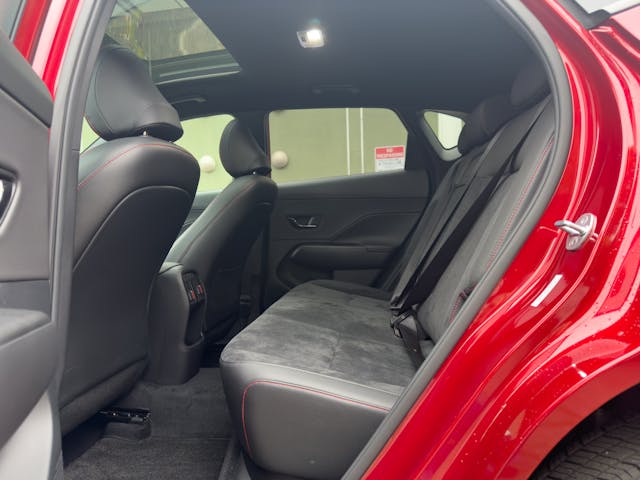
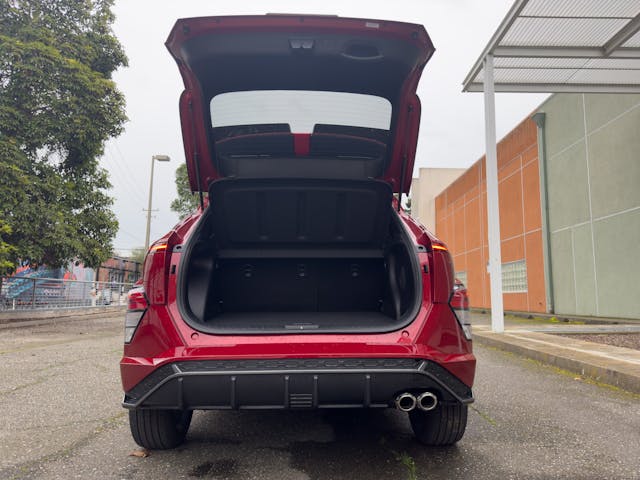
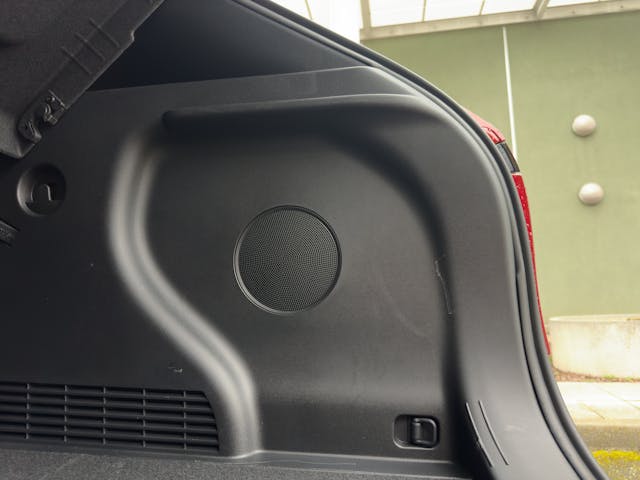
The budget-conscious can build out an SE ($25,585) or SEL model ($26,935) with front-wheel drive. Not only are those configurations cheaper, but the FWD driveline is more fuel efficient. (As of this writing, the EPA has not released fuel economy figures for either engine, though Hyundai quotes the 1.6 at 26/32/28 mpg city/highway/combined for the FWD version and 24/29/26 mpg for the AWD model.) The budget route has its perks, still: For 2024, Hyundai offers the Kona in nine colors, including three particularly vibrant new ones: orange, lime green, and a lovely sage. All examples get the blade-like touchscreen, though the instrument cluster readout is different for the two lower trims. On the SE and SEL, you’ll sacrifice the sunroof and the Bose stereo, but you can add back heated seats, wireless charging, and the digital instrument cluster section for $2200 on an SEL and still squeak in for under $30K. In our minds, the only reason to spend more than that for a Kona is for the all-out N model, which, judging from the previous generation of the Kona, will be as different from the N Line as Sweetgreen’s Crispy Rice Salad is from authentic bibimbap. (Hyundai hasn’t talked about the second-gen N model yet, but we can promise you’ll hear from us when it does.)
Most people will find the 2024 Kona to be a serviceable companion for city or suburban needs, an affordable vehicle with useful space and attractive style. As of the 2024 model year, the Kona is confident and stylish like never before, and the main reason we’re harsh on the performance of the N Line variant is because N has proved, multiple times over, that it is a sub-brand worth taking seriously. N Line? A shouty trim level on this workaday crossover, but a compelling one, at that.
2024 Hyundai Kona N Line AWD
Highs: Unique exterior style, thoroughly Korean-made with a great warranty, airy interior with quality materials
Lows: N Line styling promises more performance than the driveline can deliver.
Summary: Beneath the genuinely head-turning body kit, this is a competent compact crossover that will faithfully serve you and your budget.
***
Check out the Hagerty Media homepage so you don’t miss a single story, or better yet, bookmark it. To get our best stories delivered right to your inbox, subscribe to our newsletters.
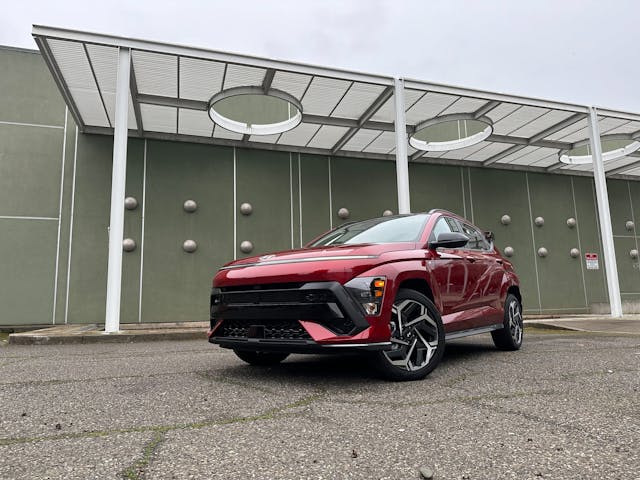


Where’s the obligatory photo of the author driving in California?